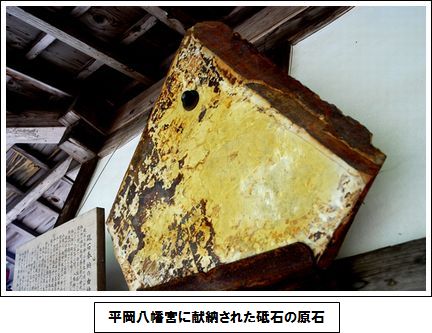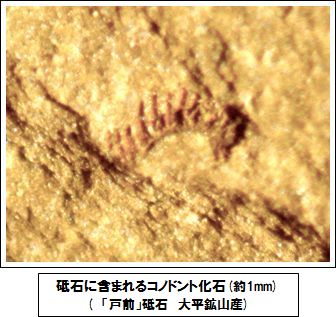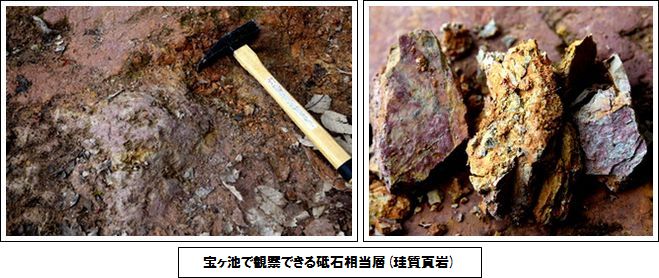
学校から徒歩5分の宝ヶ池の山には、約2億年前の深海底で起こった自然の営みが見事に刻まれています。大繁殖したプランクトンの放散虫が堆積した「層状チャ-ト」とは別に、ある時期にはとても細かな粒子が堆積した時期がありました。この粒子は当時の大陸から風によって舞い上げられたものが、大洋の深海底で堆積したと考えられています。この地層が宝ヶ池の山中にも露出しています。 地質学的には「珪質頁岩(砥石型珪質頁岩)」と呼ばれ、よく層状チャ-トに伴って産出します。京都では有名な「鳴滝砥石」や亀岡で現在も採掘されている砥石層と同質の岩石です。古生代二畳紀末~中生代三畳紀にかけての特徴的な地層です。この時期に地球上では一体何が起こったのでしょうか。この地層には「海洋無酸素事変」の産物と言われている炭素濃集層(Black band)が含まれることもあり、海洋の95%の生物がこの時期に絶滅したとも推測されています。
地質学的には「珪質頁岩(砥石型珪質頁岩)」と呼ばれ、よく層状チャ-トに伴って産出します。京都では有名な「鳴滝砥石」や亀岡で現在も採掘されている砥石層と同質の岩石です。古生代二畳紀末~中生代三畳紀にかけての特徴的な地層です。この時期に地球上では一体何が起こったのでしょうか。この地層には「海洋無酸素事変」の産物と言われている炭素濃集層(Black band)が含まれることもあり、海洋の95%の生物がこの時期に絶滅したとも推測されています。
砥石には、写真のようなコノドント化石もよく含まれていますが、この動物は三畳紀末で絶滅しました。このコノドントも形態が時代とともに変化し、重要な示準化石のひとつです。

If you walk about 5 minutes from our school to the hills of Takaragaike, you can see what happened about 200 million years ago when nature was at work. As well as the layered chert that formed from the sedimentation of radiolarian, some very fine particles formed some sedimentation at some point in time. Those particles were blown by the wind from the land, and formed sedimentation on the bottom of the ocean. That strata became exposed in the hills of Takaragaike.
In geological terms, this is known as “Siliceous Shale”, and it often produced with layered chert. It is a rock that is the same as the famous Narutaki Grindstone in Kyoto, and the Grindstone that is currently being mined in Kameoka. This is a characteristic of the strata formed between the Permian period and the Triassic period. We wonder what happened on the earth around this time? This strata contains a carbon concentrated layer or “Black Band” which is a product of an anoxic event in the ocean, and it is presumed that 95% of the organisms in the oceans became extinct during this period.
As you can see in the photos, Conodont fossils are often found in the Grindstone (or Sharpening stone), and these animals became extinct in the Triassic period. This Conodont changed its form over the years and became an important index fossil.
《Words》 珪質頁岩 siliceous shale、砥石 Sharpening stone、コノドント Conodont



